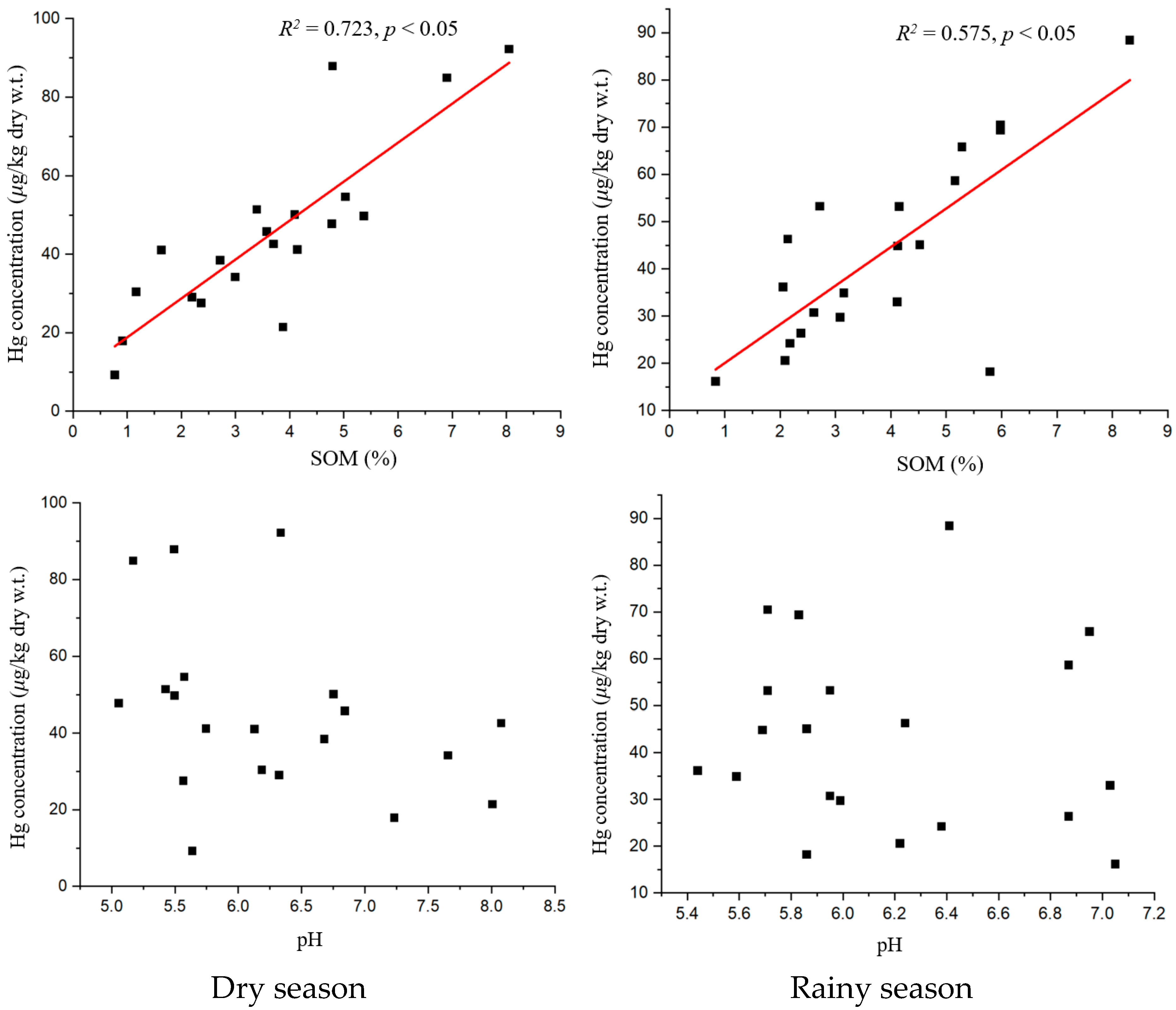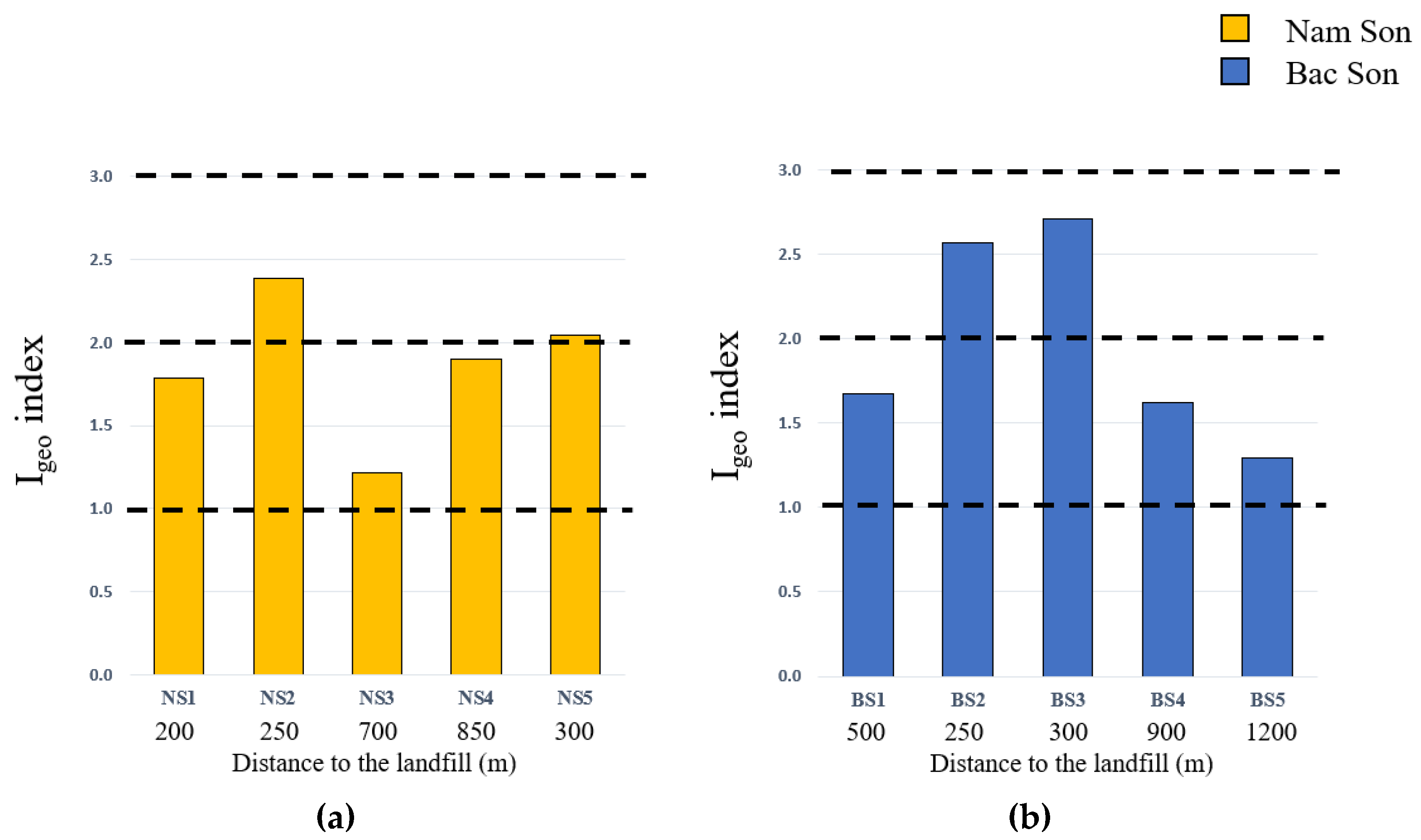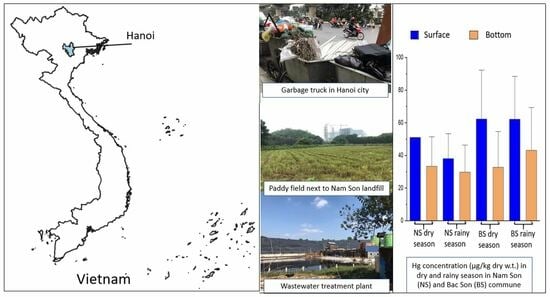Spatial and Seasonal Patterns of Mercury Accumulation in Paddy Soil around Nam Son Landfill, Hanoi, Vietnam
Abstract
1. Introduction
2. Materials and Methods
2.1. Sampling Sites
2.2. Sample Collection
2.3. Sample Analysis
2.3.1. Hg Analysis
2.3.2. pH Analysis
2.3.3. Determination of SOM in Soil Sample
- W1: is the weight of the soil sample before burning;
- W2: is the weight of the soil sample after burning.
2.4. Quality Assurance (QA) and Quality Control (QC)
2.5. Geo-Accumulation Index
- Igeo: geo-accumulation index for Hg;
- CHg: Hg concentration in the soil (the average Hg concentration in each soil sample);
- BHg: local Hg background (the Hg concentration (7.47 μg/kg dry w.t.) of the bottom layer from the reference sampling point [26]);
- 1.5: the factor used to correct lithogenic effects.
2.6. Statistical Analysis
3. Results and Discussion
3.1. Hg Concentration in Soil
3.2. Vertical Distribution of Hg Concentration
3.3. Effect of pH and SOM on Hg Concentration in Soils
3.4. Geo-Accumulation (Igeo) in Soil
4. Conclusions
Author Contributions
Funding
Institutional Review Board Statement
Informed Consent Statement
Data Availability Statement
Acknowledgments
Conflicts of Interest
References
- Dziok, T.; Kołodziejska, E.K.; Kołodziejska, E.L. Mercury content in woody biomass and its removal in the torrefaction process. Biomass Bioenergy 2020, 143, 105832. [Google Scholar] [CrossRef]
- Luo, Q.; Ren, Y.; Sun, Z.; Li, Y.; Li, B.; Yang, S.; Zhang, W.; Hu, Y.; Cheng, H. Atmospheric mercury pollution caused by fluorescent lamp manufacturing and the associated human health risk in a large industrial and commercial city. Environ. Pollut. 2021, 269, 116146. [Google Scholar] [CrossRef]
- Xu, J.; Zhang, J.; Lv, Y.; Xu, K.; Lu, S.; Liu, X.; Yang, Y. Effect of soil mercury pollution on ginger (Zingiber officinale Roscoe): Growth, product quality, health risks and silicon mitigation. Ecotoxicol. Environ. Saf. 2020, 195, 110472. [Google Scholar] [CrossRef]
- Mergler, D.; Anderson, H.A.; Chan, L.H.M.; Mahaffey, K.R.; Murray, M.; Sakamoto, M.; Stern, A.H. Methylmercury exposure and health effects in humans: A worldwide concern. Ambio 2007, 36, 3–11. [Google Scholar] [CrossRef]
- Azevedo, B.F.; Furieri, L.B.; Pe, F.M.; Wiggers, G.A.; Vassallo, P.F.; Simões, M.R.; Fiorim, J.; de Batista, P.R.; Fioresi, M.; Rossoni, L.; et al. Toxic effects of mercury on the cardiovascular and central nervous systems. J. Biomed. Biotechnol. 2012, 2012, 949048. [Google Scholar] [CrossRef]
- Cariccio, V.L.; Samà, A.; Bramanti, P.; Mazzon, E. Mercury Involvement in Neuronal Damage and in Neurodegenerative Diseases. Biol. Trace Elem. Res. 2019, 187, 341–356. [Google Scholar] [CrossRef] [PubMed]
- Pérez-Vázquez, K.S.-V.F.J.; Ávila-García, I.P.; Méndez-Rodríguez, K.B.; Carrizalez-Yáñez, L.; Gavilán-García, A.; Vargas-Morales, J.M.; Van-Brussel, E.; Diaz-Barriga, F. A preliminary study on health impacts of Mexican mercury mining workers in a context of precarious employment. J. Trace Elem. Med. Biol. 2022, 71, 126925. [Google Scholar] [CrossRef]
- Liu, S.; Wang, X.; Guo, G.; Yan, Z. Status and environmental management of soil mercury pollution in China: A review. J. Environ. Manag. 2021, 277, 111442. [Google Scholar] [CrossRef] [PubMed]
- UN Environment. Global Mercury Supply, Trade and Demand. United Nations Environment Pro-Gramme, Chemicals and Health Branch; UN Environment: Geneva, Switzerland, 2017; Available online: https://www.unep.org/resources/report/global-mercury-supply-trade-and-demand (accessed on 28 January 2024).
- Hanoi. Minamata Convention Initial Assessment in Vietnam (Vietnam MIA Project); FINAL REPORT; The Global Environment Facility: Washington, DC, USA, 2017. [Google Scholar]
- Hamann, C.R.; Boonchai, W.; Wen, L.; Sakanashi, E.N.; Chu, C.; Hamann, K.; Hamann, C.P.; Sinniah, K.; Hamann, D. Spectrometric analysis of mercury content in 549 skin-lightening products: Is mercury toxicity a hidden global health hazard? J. Am. Acad. Dermatol. 2014, 70, 281–287.e3. [Google Scholar] [CrossRef] [PubMed]
- Horowitz, H.M.; Jacob, D.J.; Amos, H.M.; Streets, D.G.; Sunderland, E.M. Historical mercury releases from commercial products: Global environmental implications. Environ. Sci. Technol. 2014, 48, 10242–10250. [Google Scholar] [CrossRef] [PubMed]
- Tao, Z.; Dai, S.; Chai, X. Mercury emission to the atmosphere from municipal solid waste landfills: A brief review. Atmos. Environ. 2017, 170, 303–311. [Google Scholar] [CrossRef]
- Tao, Z.; Bian, R.; Chai, X. Methylmercury levels in cover soils from two landfills in Xi’an and Shanghai, China: Implications for mercury methylation potentials. Waste Manag. 2018, 78, 331–336. [Google Scholar] [CrossRef]
- Kim, K.-H.; Kim, M.-Y.; Lee, G. The soil–air exchange characteristics of total gaseous mercury from a large-scale municipal landfill area. Atmos. Environ. 2001, 35, 3475–3493. [Google Scholar] [CrossRef]
- Hoai, S.T.; Lan, H.N.; Viet, N.T.T.; Hoang, G.N.; Kawamoto, K. Characterizing seasonal variation in landfill leachate using leachate pollution index (LPI) at nam son solid waste landfill in Hanoi, Vietnam. Environments 2021, 8, 17. [Google Scholar] [CrossRef]
- Jabłońska-Trypuć, A.; Wydro, U.; Wołejko, E.; Pietryczuk, A.; Cudowski, A.; Leszczyński, J.; Rodziewicz, J.; Janczukowicz, W.; Butarewicz, A. Potential toxicity of leachate from the municipal landfill in view of the possibility of their migration to the environment through infiltration into groundwater. Environ. Geochem. Health 2021, 43, 3683–3698. [Google Scholar] [CrossRef] [PubMed]
- Sakata, M.; Marumoto, K. Wet and dry deposition fluxes of mercury in Japan. Atmos. Environ. 2005, 39, 3139–3146. [Google Scholar] [CrossRef]
- Giang, N.V.; Kochanek, K.; Vu, N.T.; Duan, N.B. Landfill leachate assessment by hydrological and geophysical data: Case study NamSon, Hanoi, Vietnam. J. Mater. Cycles Waste Manag. 2018, 20, 1648–1662. [Google Scholar] [CrossRef]
- The World Bank. Assessment of Management of Daily Waste and Hazardous Industrial Waste Options and Actions for Implementation of the National Strategy; The World Bank: Washington, DC, USA, 2018. (In Vietnamese) [Google Scholar]
- Hanoi Urban Environment Company (URENCO). Plan on Management and Operation of Nam Son Waste Disposal Area, from 2018–2020; Hanoi Urban Environment Company: Hanoi, Vietnam, 2018. [Google Scholar]
- Kodamatani, H.; Maeda, C.; Balogh, S.J.; Nollet, Y.H.; Kanzaki, R.; Tomiyasu, T. The influence of sample drying and storage conditions on methylmercury determination in soils and sediments. Chemosphere 2017, 173, 380–386. [Google Scholar] [CrossRef]
- Addai-Arhin, S.; Novirsa, R.; Jeong, H.H.; Phan, Q.D.; Hirota, N.; Ishibashi, Y.; Shiratsuchi, H.; Arizono, K. The human health risks assessment of mercury in soils and plantains from farms in selected artisanal and small-scale gold mining communities around Obuasi, Ghana. J. Appl. Toxicol. 2022, 42, 258–273. [Google Scholar] [CrossRef]
- Lewis, D.B.; Brown, J.A.; Jimenez, K.L. Effects of flooding and warming on soil organic matter mineralization in Avicennia germinans mangrove forests and Juncus roemerianus salt marshes. Estuar. Coast. Shelf Sci. 2014, 139, 11–19. [Google Scholar] [CrossRef]
- Muller, G. Index of geo-accumulation in sediments of the Rhine River. J. Geol. 1969, 2, 108–118. [Google Scholar]
- Bolaños-Álvarez, Y.; Alonso-Hernández, C.M.; Morabito, R.; Díaz-Asencio, M.; Pinto, V.; Gómez-Batista, M. Mercury contamination of riverine sediments in the vicinity of a mercury cell chlor-alkali plant in Sagua River, Cuba. Chemosphere 2016, 152, 376–382. [Google Scholar] [CrossRef] [PubMed]
- QCVN 03:2023/BTNMT; National Technical Regulation on Soil Quality. The Ministry of Natural Resources and Environment (MONRE): Hanoi, Vietnam, 2023. Available online: https://datafiles.chinhphu.vn/cpp/files/vbpq/2023/3/01-btnmt-qc03.pdf (accessed on 28 January 2024). (In Vietnamese)
- He, C.; Arizono, K.; Ji, H.; Yakushiji, Y.; Zhang, D.; Ishibashi, K.H.Y. Spatial distribution characteristics of mercury in the soils and native earthworms (Bimastos parvus) of the leachate-contaminated zone around a traditional landfill. Sci. Total Environ. 2018, 636, 1565–1576. [Google Scholar] [CrossRef] [PubMed]
- Zhu, W.; Li, Z.; Chai, X.; Hao, Y.; Lin, C.; Sommar, J.; Feng, X. Emission characteristics and air-surface exchange of gaseous mercury at the largest active landfill in Asia. Atmos. Environ. 2013, 79, 188–197. [Google Scholar] [CrossRef]
- Li, Q.; Tang, L.; Qiu, G.; Liu, C. Total mercury and methylmercury in the soil and vegetation of a riparian zone along a mercury-impacted reservoir. Sci. Total Environ. 2020, 738, 139794. [Google Scholar] [CrossRef] [PubMed]
- Raghavan, S.V.; Vu, M.T.; Liong, S.Y. Ensemble climate projections of mean and extreme rainfall over Vietnam. Glob. Planet. Chang. 2017, 148, 96–104. [Google Scholar] [CrossRef]
- Gabriel, M.C.; Williamson, D.G.; Brooks, S. Potential impact of rainfall on the air-surface exchange of total gaseous mercury from two common urban ground surfaces. Atmos. Environ. 2011, 45, 1766–1774. [Google Scholar] [CrossRef]
- Barletta, M.; Lucena, L.R.R.; Costa, M.F.; Barbosa-Cintra, S.C.T.; Cysneiros, F.J.A. The interaction rainfall vs. weight as determinant of total mercury concentration in fish from a tropical estuary. Environ. Pollut. 2012, 167, 1–6. [Google Scholar] [CrossRef]
- Meng, M.; Li, B.; Shao, J.; Wang, T.; He, B.; Shi, J.; Ye, Z.; Jiang, G. Accumulation of total mercury and methylmercury in rice plants collected from different mining areas in China. Environ. Pollut. 2014, 184, 179–186. [Google Scholar] [CrossRef]
- Loo, Y.Y.; Billa, L.; Singh, A. Effect of climate change on seasonal monsoon in Asia and its impact on the variability of monsoon rainfall in Southeast Asia. Geosci. Front. 2015, 6, 817–823. [Google Scholar] [CrossRef]
- Ashfold, M.J.; Latif, M.T.; Samah, A.A.; Mead, M.I.; Harris, N.R.P. Influence of Northeast Monsoon cold surges on air quality in Southeast Asia. Atmos. Environ. 2017, 166, 498–509. [Google Scholar] [CrossRef][Green Version]
- Chen, L.; Liu, M.; Xu, Z.; Fan, R.; Tao, J.; Chen, D.; Zhang, D.; Xie, D.; Sun, J. Variation trends and influencing factors of total gaseous mercury inthe Pearl River Delta-A highly industrialised region in South China influenced by seasonal monsoons. Atmos. Environ. 2013, 77, 757–766. [Google Scholar] [CrossRef]
- Morosini, C.; Terzaghi, E.; Raspa, G.; Zanardini, E.; Anelli, S.; Armiraglio, S.; Petranich, E.; Covelli, S.; Guardo, A.D. Mercury vertical and horizontal concentrations in agricultural soils of a historically contaminated site: Role of soil properties, chemical loading, and cultivated plant species in driving its mobility. Environ. Pollut. 2021, 285, 117467. [Google Scholar] [CrossRef]
- Wang, C.; Wang, Z.; Gao, Y.; Zhang, X. Planular-vertical distribution and pollution characteristics of cropland soil Hg and the estimated soil–air exchange fluxes of gaseous Hg over croplands in northern China. Environ. Res. 2021, 195, 110810. [Google Scholar] [CrossRef] [PubMed]
- Yu, H.; Li, J.; Luan, Y. Meta-analysis of soil mercury accumulation by vegetables. Sci. Rep. 2018, 8, 1261. [Google Scholar] [CrossRef] [PubMed]
- Braaten, H.F.V.; de Wit, H.A. Effects of disturbance and vegetation type on total and methylmercury in boreal peatland and forest soils. Environ. Pollut. 2016, 218, 140–149. [Google Scholar] [CrossRef]
- Tomiyasu, T.; Komadatani, H.; Imura, R.; Matsuyama, A.; Miyamoto, J.; Akagi, H.; Kocman, D.; Kotnik, J.; Fajon, V.; Horvat, M. The dynamics of mercury near Idrija mercury mine, Slovenia: Horizontal and vertical distributions of total, methyl, and ethyl mercury concentrations in soils. Chemosphere 2017, 184, 244–252. [Google Scholar] [CrossRef]
- Liu, B.; Tian, K.; He, Y.; Hu, W.; Huang, B.; Zhang, X.; Zhao, L.; Teng, Y. Dominant roles of torrential floods and atmospheric deposition revealed by quantitative source apportionment of potentially toxic elements in agricultural soils around a historical mercury mine, Southwest China. Ecotoxicol. Environ. Saf. 2022, 242, 244–252. [Google Scholar] [CrossRef]
- Li, Y.; Zhang, F.; Yang, M.; Zhang, J.; Xie, Y. Impacts of biochar application rates and particle sizes on runoff and soil loss in small cultivated loess plots under simulated rainfall. Sci. Total Environ. 2019, 649, 1403–1413. [Google Scholar] [CrossRef]
- Yang, Y.-K.; Cheng, Z.; Shi, X.-J.; Tao, L.; Wang, D.-Y. Effect of organic matter and pH on mercury release from soils. J. Environ. Sci. 2007, 19, 1349–1354. [Google Scholar] [CrossRef]
- Chang, C.Y.; Yu, H.Y.; Chen, J.J.; Li, F.B.; Zhang, H.H.; Liu, C.P. Accumulation of heavy metals in leaf vegetables from agricultural soils and associated potential health risks in the Pearl River Delta, South China. Environ. Monit. Assess. 2014, 186, 1547–1560. [Google Scholar] [CrossRef]
- Natasha; Shahid, M.; Khalid, S.; Bibi, I.; Bundschuh, J.; Niazi, N.K.; Dumat, C. A critical review of mercury speciation, bioavailability, toxicity and detoxification in soil-plant environment: Ecotoxicology and health risk assessment. Sci. Total Environ. 2019, 711, 134749. [Google Scholar] [CrossRef]
- Duc, T.A.; Vachaud, G.; Bonnet, M.P.; Prieur, N.; Loi, V.D.; Anh, L.L. Experimental investigation and modelling approach of the impact of urban wastewater on a tropical river; a case study of the Nhue River, Hanoi, Viet Nam. J. Hydrol. 2007, 334, 347–358. [Google Scholar] [CrossRef]
- Bortey-Sam, N.; Nakayama, S.M.M.; Akoto, O.; Ikenaka, Y.; Fobil, J.N.; Baidoo, E.; Mizukawa, H.; Ishizuka, M. Accumulation of heavy metals and metalloid in foodstuffs from agricultural soils around Tarkwa area in Ghana, and associated human health risks. Int. J. Environ. Res. Public Health 2015, 12, 8811–8827. [Google Scholar] [CrossRef]





| Class 0 | Igeo ≤ 0 | Unpolluted |
| Class 1 | 0 < Igeo ≤ 1 | Unpolluted to moderately polluted |
| Class 2 | 1 < Igeo ≤ 2 | Moderately polluted |
| Class 3 | 2 < Igeo ≤ 3 | Moderately to heavily polluted |
| Class 4 | 3 < Igeo ≤ 4 | Heavily polluted |
| Class 5 | 4 < Igeo ≤ 5 | Heavily to extremely polluted |
| Class 6 | 5 < Igeo | Extremely polluted |
| Sampling Point | Hg Concentration in September 2021 | Hg Concentration in January 2022 | ||
|---|---|---|---|---|
| Surface (0–5 cm) | Bottom (20–25 cm) | Surface (0–5 cm) | Bottom (20–25 cm) | |
| Ref | - | - | 25.8 ± 2.16 | 7.47 ± 0.80 |
| NS1 | 34.9 ± 2.04 | 29.7 ± 2.33 | 49.7 ± 2.33 | 27.5 ± 0.71 |
| NS2 | 44.9 ± 0.43 | 20.6 ± 0.41 | 87.9 ± 9.20 | 29.0 ± 2.08 |
| NS3 | 26.3 ± 3.31 | 16.2 ± 0.54 | 34.2 ± 3.37 | 17.9 ± 1.19 |
| NS4 | 53.2 ± 3.87 | 46.3 ± 3.99 | 42.6 ± 2.54 | 41.1 ± 1.88 |
| NS5 | 30.7 ± 1.99 | 36.2 ± 0.21 | 41.1 ± 5.17 | 51.4 ± 0.22 |
| BS1 | 70.5 ± 0.96 | 45.1 ± 2.28 | 50.1 ± 3.19 | 21.4 ± 0.79 |
| BS2 | 65.8 ± 0.94 | 58.6 ± 1.12 | 84.9 ± 4.41 | 47.7 ± 2.59 |
| BS3 | 88.4 ± 3.52 | 69.4 ± 0.31 | 92.2 ± 2.55 | 54.6 ± 4.26 |
| BS4 | 33.0 ± 1.50 | 24.2 ± 0.57 | 38.4 ± 1.47 | 30.4 ± 2.08 |
| BS5 | 53.2 ± 5.42 | 18.2 ± 1.86 | 45.8 ± 1.99 | 9.23 ± 1.80 |
Disclaimer/Publisher’s Note: The statements, opinions and data contained in all publications are solely those of the individual author(s) and contributor(s) and not of MDPI and/or the editor(s). MDPI and/or the editor(s) disclaim responsibility for any injury to people or property resulting from any ideas, methods, instructions or products referred to in the content. |
© 2024 by the authors. Licensee MDPI, Basel, Switzerland. This article is an open access article distributed under the terms and conditions of the Creative Commons Attribution (CC BY) license (https://creativecommons.org/licenses/by/4.0/).
Share and Cite
Thi Quynh, N.; Jeong, H.; Elwaleed, A.; Nugraha, W.C.; Arizono, K.; Agusa, T.; Ishibashi, Y. Spatial and Seasonal Patterns of Mercury Accumulation in Paddy Soil around Nam Son Landfill, Hanoi, Vietnam. Soil Syst. 2024, 8, 30. https://doi.org/10.3390/soilsystems8010030
Thi Quynh N, Jeong H, Elwaleed A, Nugraha WC, Arizono K, Agusa T, Ishibashi Y. Spatial and Seasonal Patterns of Mercury Accumulation in Paddy Soil around Nam Son Landfill, Hanoi, Vietnam. Soil Systems. 2024; 8(1):30. https://doi.org/10.3390/soilsystems8010030
Chicago/Turabian StyleThi Quynh, Nguyen, Huiho Jeong, Ahmed Elwaleed, Willy Cahya Nugraha, Koji Arizono, Tetsuro Agusa, and Yasuhiro Ishibashi. 2024. "Spatial and Seasonal Patterns of Mercury Accumulation in Paddy Soil around Nam Son Landfill, Hanoi, Vietnam" Soil Systems 8, no. 1: 30. https://doi.org/10.3390/soilsystems8010030
APA StyleThi Quynh, N., Jeong, H., Elwaleed, A., Nugraha, W. C., Arizono, K., Agusa, T., & Ishibashi, Y. (2024). Spatial and Seasonal Patterns of Mercury Accumulation in Paddy Soil around Nam Son Landfill, Hanoi, Vietnam. Soil Systems, 8(1), 30. https://doi.org/10.3390/soilsystems8010030











